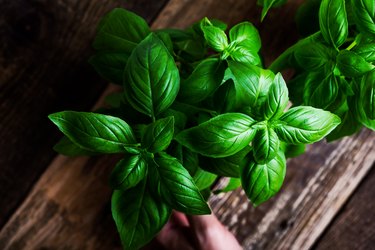
Growing fresh herbs in your own home garden is relatively easy, and the best part is that they often do not need constant grooming and upkeep. However, how do you tell the difference between basil (Ocimum spp.) and mint (Mentha spp.) if the plants have begun growing together or if you simply forgot what you planted? Luckily, there are several easy ways to differentiate these plants to make sure you use the right herb in the right recipes.
Mint and Basil Appearance
Video of the Day
The first thing you may do is look at your herb plants to see how they look different. It may be difficult to differentiate between basil and mint because there are many variations of each herb and each variation looks different from the next. This means that there is not quite a universal look for basil or for mint, but they are still easy to identify based on other characteristics.
Video of the Day
The most popular basil plant is usually the sweet basil that is also known as the Genovese or Italian basil. The leaves are smooth and bright green with no harsh jagged edges. The leaves have a rounded appearance starting at the base of the leaf and moving into a slight point at the tip. They also tend to have a bowed effect due to the edges that may curl toward the underside of the leaves.
Mint has a completely different appearance when placed next to a basil plant. Compared to the smooth and sleek look of the sweet basil leaves, the mint leaves look much rougher and textured. They have jagged edges along the leaf edges and also tend to have a fuzzy appearance. While the mint herb plant has unique physical traits, the best way to identify a mint plant is through smell.
Scent Identification Factors
Mint and basil plants each have a strong identifying scent. Mint has a distinct menthol fragrance that is also cool to the taste if you bite down on a leaf. All you need to do is simply rub the leaves between your fingers and the scent will start drifting up to your nose. It is a sharp scent that is not unpleasant but often smells like the cough drops you use when you are sick. There are many variants of the mint plant, the most common being spearmint or peppermint; however, they all have the distinct menthol scent and flavor that differ slightly with each type of mint plant.
Basil plants also have a distinct scent if you rub the leaves between your fingers. It has a strong fragrance as well, so you won't have to inhale too deeply to get the hints of clove and anise that the fresh basil plant emits. The unique scent of basil carries through all types of basil plants, even those like lavender, lemon or cinnamon basil.
Dried Basil and Mint
The best time to identify the plants is when they are fresh on the stems. When the herbs are dried, it becomes harder to differentiate the two, as they both lose many identifying characteristics. When they are dried, the appearance of the leaves cannot be easily used in order to tell these two herbs apart. The best way to identify dried mint or basil is to use the senses of smell and taste to make sure you are using the right herb.
When basil and mint are dried for later use, their color dulls considerably and their flavors and scents slightly change as well. The unique fragrance that fresh basil provides is somewhat lost when the leaves are dried. Mint plants also lose their bright colors when their leaves are dried, but luckily, the menthol scent is still recognizable even if it is not as strong as when the leaves are fresh.